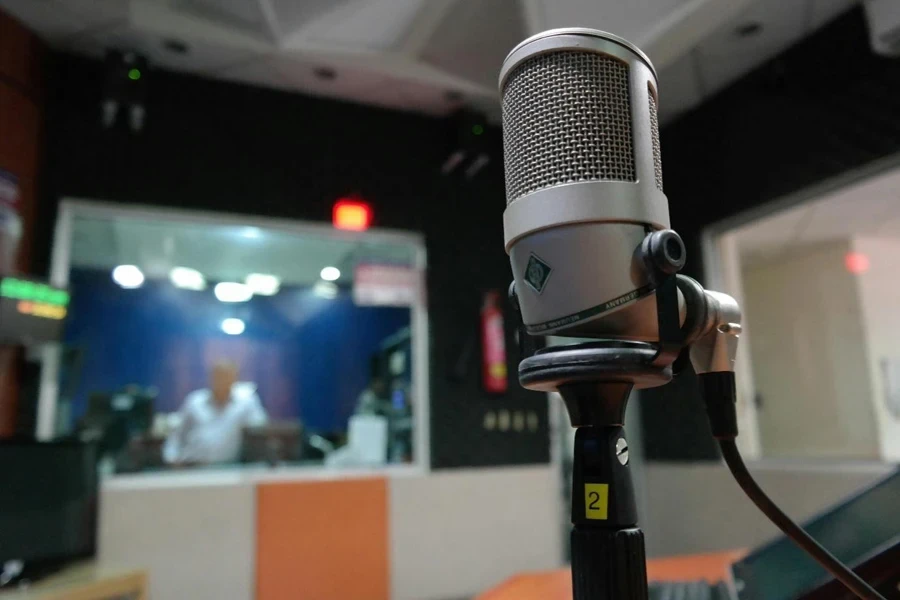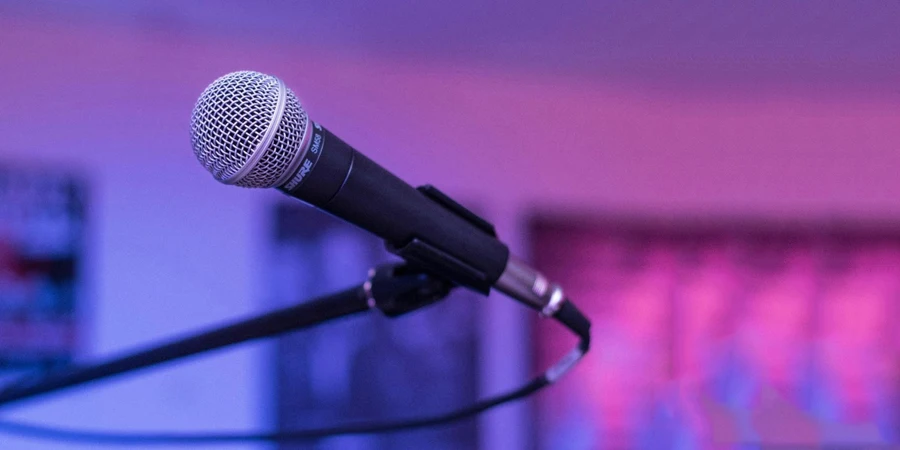Key Takeaway
- Market Growth: Projected to grow from USD 2.45B in 2023 to USD 3.53B by 2028 with a 7.5% CAGR.
- Technological Innovations: Advancements in MEMS, ECMs, and EQset technology enhance performance and accuracy.
- Regional Dynamics: North America leads, while Asia Pacific expects the highest growth.
- Top-Selling Models: Versatile, durable, high SPL, and modeling microphones drive market trends.
- Applications: Increased demand across live streaming, short video shooting, broadcasting, gaming, telecommunication, and smart devices.

The global microphone market has seen significant growth in recent years, driven by advancements in audio technology and increasing demand from various industries. Key innovations in MEMS and electret condenser microphones have enhanced performance, while new technologies like EQset have simplified setups and improved accuracy.
Market dynamics highlight a strong CAGR and dominant regions such as North America and Asia Pacific. Top-selling models continue to drive trends with their versatility, durability, and cutting-edge features.
This article delves into these market dynamics, technological innovations, and top-selling models shaping the industry this year.
Table of Contents
● Market overview
● Key technology and design innovations
● Top-selling models driving market trends
Market overview

Market scale and growth
The global microphone market is projected to grow from USD 2,454 million in 2023 to USD 3,526 million by 2028, with a Compound Annual Growth Rate (CAGR) of 7.5%, according to MarketsandMarkets.
This growth is driven by continuous advancements in audio technology, such as noise cancellation, beamforming, and high-fidelity audio capture, boosting demand across industries like broadcasting, gaming, and telecommunication. The rise of intelligent home automation and voice-controlled systems also plays a significant role, with increasing use in devices like smart speakers and security systems.
Regional insights
In terms of market shares, North America is leading, while the Asia Pacific region is expected to experience the highest CAGR during the forecast period. Factors contributing to this growth include the growing popularity of consumer electronics, such as smartphones, laptops, and wearables, which require built-in microphones for various functionalities.
Additionally, the adoption of voice-controlled virtual assistants like Siri, Google Assistant, and Alexa fuels the demand for good quality microphones. The industry also faces challenges such as compatibility issues and intense competition, yet opportunities abound with the increasing demand for wearable and hearable devices.
Key technology and design innovations

MEMS microphones
MEMS (Micro-Electro-Mechanical System) microphones are distinguished by their miniature size, low power consumption, and robust durability, making them ideal for modern compact electronic devices.
Typically, MEMS microphones incorporate a silicon-based diaphragm etched onto a semiconductor die, creating a capacitor that converts sound waves into electrical signals. They feature an audio preamplifier integrated onto the same die, providing both analog and digital outputs. With an inherent signal-to-noise ratio (SNR) often exceeding 64 dB and power consumption as low as 150 µA, these microphones offer superior performance in electrically noisy environments.
The compact design, which can be as small as 2.75 x 1.85 mm, facilitates easy integration into smartphones, wearables, and IoT devices, providing stable performance even under high vibration conditions.
Electret condenser microphones
Electret Condenser Microphones (ECM) leverage a permanently charged material (electret) to function as a diaphragm. This diaphragm is placed near a conductive backplate, forming a parallel-plate capacitor. Sound waves cause variations in capacitance, translating to voltage changes captured by an internal JFET preamplifier.
ECMs are characterized by their wide dynamic range, with a typical frequency response from 20 Hz to 20 kHz and SNR around 60 dB. They are favored in legacy applications due to their high Ingress Protection (IP) ratings, often reaching IP67, ensuring resistance to dust and water.
ECMs offer design flexibility with options for through-hole, surface mount, and wire lead configurations, making them suitable for applications requiring robust environmental resistance and a broad operational voltage range from 1.5V to 10V.
New technologies: EQset by GRAS
The EQset technology represents a significant advancement, ensuring fixed sensitivity and a flat frequency response from 20 Hz to 20 kHz across all units. This technology integrates a high-precision calibration system within the microphone, eliminating the need for individual adjustments and reducing measurement uncertainty to less than 0.1 dB. With a THD (Total Harmonic Distortion) of less than 0.05% at 94 dB SPL, EQset microphones deliver highly accurate acoustic measurements.
The technology is particularly beneficial for applications in consumer audio and telecom where precise sound capture and reproduction are critical. It supports seamless integration with both 48V phantom power systems and CCP (Constant Current Power) setups, providing flexibility and compatibility with existing audio infrastructure.
Top-selling models driving market trends

Versatile microphones
Versatile microphones are defined by their flat frequency response, high SPL (Sound Pressure Level) handling, and cardioid pickup pattern.
The flat frequency response, typically ranging from 20 Hz to 20 kHz, ensures accurate sound reproduction across the audible spectrum.
High SPL handling, often exceeding 140 dB, allows these microphones to capture loud sound sources without distortion, making them suitable for dynamic environments like live performances and studio recordings.
The cardioid pattern effectively isolates the sound source, minimizing background noise and feedback, which is essential for applications such as vocals, instruments, podcasting, and streaming.
Warm and punchy sound microphones
Microphones designed for warm and punchy sound excel at capturing subtle details and transients, making them ideal for high-output applications like drums and percussion. These microphones typically feature a ribbon or dynamic capsule, which provides a smooth frequency response with a slight boost in the lower-mid frequencies, enhancing the warmth of the sound.
They often have a fast transient response, capturing the quick attack of percussive instruments with precision. Technical specifications may include a frequency response range of 30 Hz to 15 kHz and an SPL handling of up to 150 dB, ensuring clarity and detail in high-energy recording environments.
Durable and omnidirectional microphones
Durable microphones with omnidirectional pickup patterns are designed to handle high maximum SPLs, typically around 140 dB, and provide a smooth frequency response. These microphones are built with robust enclosures, often featuring metal housings that can withstand physical shocks, humidity, and extreme temperatures.
The omnidirectional pattern captures sound uniformly from all directions, making them ideal for broadcasting, field recording, and capturing ambient sounds. Their durable design ensures reliable performance in harsh environments, and they often feature weather-resistant seals and coatings for additional protection.

High SPL and versatile microphones
High SPL microphones with versatile applications usually feature a focused cardioid pattern and built-in bass roll-off switches. The cardioid pattern provides excellent off-axis rejection, which is crucial for isolating the desired sound source in noisy environments. These microphones can handle SPL levels up to 155 dB, making them suitable for loud sound sources like drums, brass instruments, and amplified instruments.
The built-in bass roll-off switch helps to reduce low-frequency rumble and proximity effect, ensuring a cleaner sound in various recording situations. Frequency response ranges from 20 Hz to 18 kHz provide a balanced sound profile for a wide range of applications.
Modeling microphones
Modeling microphones utilize advanced emulation technology to replicate the sound characteristics of multiple classic microphones within a single unit. These microphones often incorporate multiple capsules and advanced DSP (Digital Signal Processing) to switch between different microphone models, offering unparalleled flexibility in sound shaping.
Key features include a wide frequency response range (typically 20 Hz to 20 kHz), low self-noise (below 10 dB-A), and high SPL handling (up to 140 dB). Modeling microphones come with software that allows users to change the mic model and polar pattern in real-time, providing an extensive palette of tonal options for creative audio recording solutions. This technology is particularly valuable in studio settings, allowing engineers and producers to experiment with different microphone characteristics without needing multiple physical microphones.
Conclusion

The 2023 microphone market is characterized by rapid technological advancements and diverse application demands. Innovations in MEMS and condenser technologies, along with the popularity of versatile and durable models, continue to drive growth and shape industry trends. As the market evolves, these advancements are expected to meet the increasing demands for good quality audio in various sectors, ensuring sustained growth and continued innovation in the microphone industry.




